Exceptional characters and prime numbers in sparse sets
IF 1
1区 数学
Q2 MATHEMATICS
引用次数: 0
Abstract
We develop a lower bound sieve for primes under the (unlikely) assumption of infinitely many exceptional characters. Compared with the illusory sieve due to Friedlander and Iwaniec which produces asymptotic formulas, we show that less arithmetic information is required to prove nontrivial lower bounds. As an application of our method, assuming the existence of infinitely many exceptional characters we show that there are infinitely many primes of the form .
稀疏集合中的异常字符和素数
我们根据无穷多例外字符(不太可能)的假设,开发了一种素数下限筛。与弗里德兰德和伊瓦尼茨提出的产生渐近公式的虚幻筛法相比,我们证明了证明非微不足道的下界所需的算术信息更少。作为我们方法的一个应用,假设存在无限多的特殊字符,我们证明存在无限多的 a2+ b8 形式的素数。
本文章由计算机程序翻译,如有差异,请以英文原文为准。
求助全文
约1分钟内获得全文
求助全文
来源期刊

Algebra & Number Theory
MATHEMATICS-
CiteScore
1.80
自引率
7.70%
发文量
52
审稿时长
6-12 weeks
期刊介绍:
ANT’s inclusive definition of algebra and number theory allows it to print research covering a wide range of subtopics, including algebraic and arithmetic geometry. ANT publishes high-quality articles of interest to a broad readership, at a level surpassing all but the top four or five mathematics journals. It exists in both print and electronic forms.
The policies of ANT are set by the editorial board — a group of working mathematicians — rather than by a profit-oriented company, so they will remain friendly to mathematicians'' interests. In particular, they will promote broad dissemination, easy electronic access, and permissive use of content to the greatest extent compatible with survival of the journal. All electronic content becomes free and open access 5 years after publication.
 求助内容:
求助内容: 应助结果提醒方式:
应助结果提醒方式:


